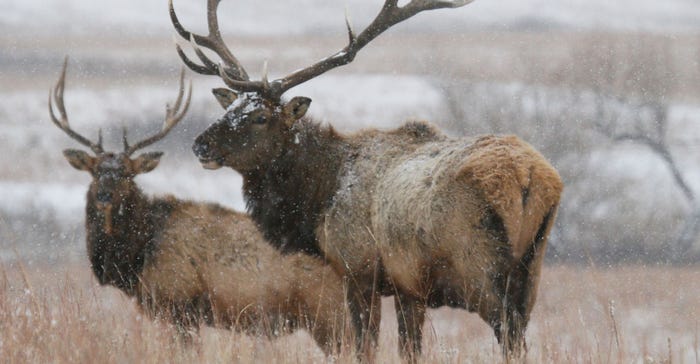December 28, 2020

A few hunting seasons back, Ed Markel headed to one of his Reno County, Kan., properties hoping to find a big deer. That, he most certainly did.
“I saw this really big deer coming down a draw. It looked huge, and I noticed it was darker than a whitetail deer. I realized pretty quickly it was an elk,” says Markel, an avid elk hunter from Pretty Prairie. “Here came this big cow elk, right there walking across my 80. It passed right by me.”
Such sightings are becoming increasingly common all across Kansas. One nice bull has been photographed repeatedly, and recently, on and near our farm in Leavenworth County. A friend bowhunting in a tree in Ness County in November had a cow elk often walk directly below his perch.
Cows and calves have been seen along the Ninnescah River in Reno, Stafford and Kingman counties. Pheasant hunters near Oakley photographed a nice bull heading across a wheat field near Oakley in mid-November. Bull elk, often young, have been captured on trail cameras in at least 15 counties recently.
Many scoffed a decade or so ago when the state started offering easy-to-get permits to harvest elk, hoping to avert future problems for drivers and agriculture. A few years back, it was a big deal if two or three got harvested with such permits annually. Not anymore.
“A pretty cool fact is that we’ve [recently] had elk harvested in about one-fourth of our Kansas counties,” says Matt Peek, Kansas Department of Wildlife, Parks and Tourism biologist who keeps track of elk for the state. “It used to be Fort Riley was about the only place we had an elk harvest. Now, we get as many elk killed off Fort Riley area as on it. [Our elk herd] is really growing.”
Homecoming
In the publication “Hunting and Trading the Great Plains, 1859-75” by J.R. Mead, he mentions several sightings of elk herds in the Smoky Hills just before the Civil War. The abundance of elk, as well as bison and wild turkeys, is why he named the stream and surrounding valley “Paradise,” in current Russell County. Mentions of elk come from historical writings about the Flint Hills and even the high plains near Hays.
As were the more numerous bison, Kansas’ original elk population was doomed as market hunters and hungry homesteaders slaughtered them amazingly fast. They were mostly gone before 1890.
The comeback started in the early 1950s, when six elk were released on the then new 2,880-acre Maxwell State Wildlife Refuge in McPherson County. About three decades later, the Kansas Fish and Game released elk on the Cimarron National Grasslands. In the 1980s, they released elk at Fort Riley.
The elk flourished in all three places, even the semi-arid dessert of southwest Kansas. In fact, that herd flourished a little too well and caused problems in croplands in neighboring Oklahoma and Colorado. Most of that herd now lives on those sides of the state line. After a few seasons, Kansas stopped hunting on its side. Oklahoma and Colorado work hard to keep their herds at bay.
Maxwell’s elk population is kept in-check at around 50 animals, with annual culling by Wildlife and Parks staff. The meat usually goes to state outdoor programs or needy Kansans. Last year, over a ton of the meat was distributed to deserving families across the state.
The Fort Riley herd has varied from over 300 to down to around 125 head, thanks to limited-draw hunting. Permits allow around 10 “any elk” and a dozen “antlerless-only” per year on the post and some of the surrounding countryside. Unlike at Maxwell, Fort Riley’s herd has no towering fences to keep them in. They’ve been problematic in some private crop fields that border the military post.
New elk horizons
These days, it’s not a huge surprise to see free-ranging elk, especially in western Kansas. Herds along the Arkansas River, especially from Larned westward, may total more elk than on Fort Riley. Those elk probably followed the river drainage in from Colorado.
For at least five years, there’s been a reproducing population along the Ninnescah River drainages in Reno, Kingman and Stafford counties. More populations will come as wandering cows and bulls find each other.
While that may all be good news for those who love watching elk, it’s not good news to motorists and those in agriculture. So, here are the options Kansans have to help keep populations from becoming even more problematic:
Depredation permits. As with problematic deer, landowners can apply for depredation permits that allow them to kill elk that maybe destroying crops or threatening livestock. The elk will have to be killed where and when the damage is being done. Yes, the meat can be utilized. Contact your local game warden to begin the process.
Elk seasons. The following are the proposed 2021-22 elk seasons off Fort Riley. Permits are available at any time. They can be purchased at ksoutdoors.com or any regular license vendor.
Firearms — Aug. 1-31, Dec. 1-12 and Jan. 1 to March 15.
Archery — Sept. 13 to Dec. 31.
Muzzleloader — Sept. 1-30.
Costs. The cost of a permit varies. The first price is for any elk (bull permit), and the second price is for antlerless only (cow permit):
Landowner or tenant, $152.50 and $77.50
General resident, $302.50 and $152.50
Youth, $127.50 and $52.50
Michael Pearce writes from Lawrence, Kan.
Read more about:
WildlifeYou May Also Like




